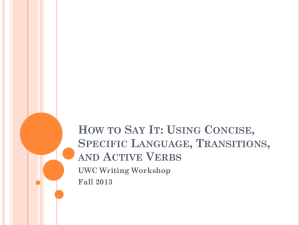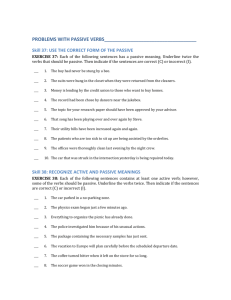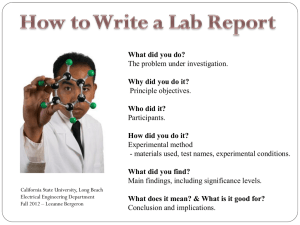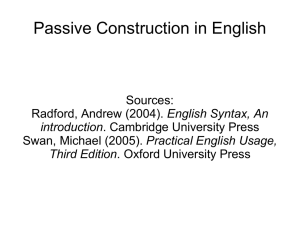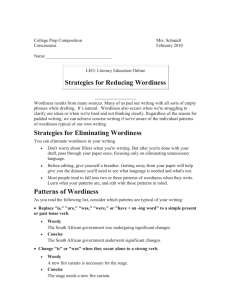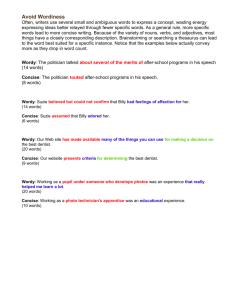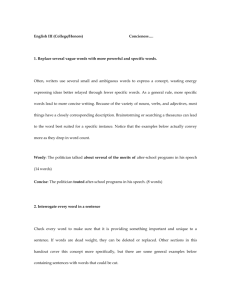Concise, Specific Language/Transitions/Verbs
advertisement
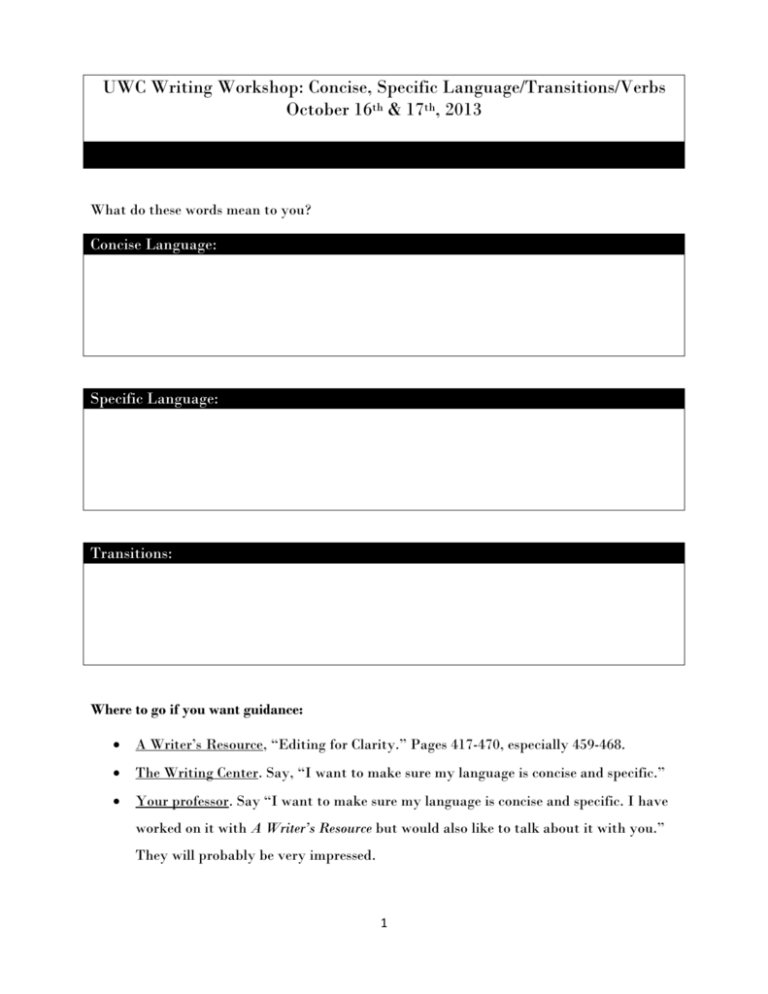
UWC Writing Workshop: Concise, Specific Language/Transitions/Verbs October 16th & 17th, 2013 What do these words mean to you? Concise Language: Specific Language: Transitions: Where to go if you want guidance: A Writer’s Resource, “Editing for Clarity.” Pages 417-470, especially 459-468. The Writing Center. Say, “I want to make sure my language is concise and specific.” Your professor. Say “I want to make sure my language is concise and specific. I have worked on it with A Writer’s Resource but would also like to talk about it with you.” They will probably be very impressed. 1 What is Concise/Specific Language? ___________: expressing or covering much in few words; brief in form but comprehensive in scope. o Bottom Line: NO extra words where they are not needed! __________: having a special application, bearing, or reference; specifying, explicit, or definite; to state one's specific purpose; concerned specifically with the item or subject named. o Bottom Line: Words used refer to the intended ideas! ___________: a body of words and the systems for their use; common to a people who are of the same community or nation, the same geographical area, or the same cultural tradition. How can I become concise and specific in my writing? AVOID… Doubling of Words (instead, choose one): o o o Intensifiers, Qualifiers (instead, omit or give specific details): o o o o Formulaic Phrases (instead, use a one-word form or omit): o o o o Catch-all Terms (instead, omit wherever possible): o o o 2 WEAK: The fact of the war had the effect of causing many changes. IMPROVED: The war caused many changes. Specifically… Padded Verbs (instead, use a one-word form): o o Unnecessary “to be” and “being” (instead, omit): o o Passive Verbs (instead, use active voice, preferably with a personal subject): o Overuse of Relative Structures (“who,” “which,” “that”-instead, omit): o o PRACTICE 1 Revise these sentences to state their meaning in fewer words. Avoid passive voice, needless repetition, and wordy phrases and clauses. The first sentence is not wordy and can serve as an example. 1. Many local farmers plan to attend next Friday's meeting. (CONCISE!) 2. Although Bradley Hall is regularly populated by students, close study of the building as a structure is seldom undertaken by them. 3. He dropped out of school on account of the fact that it was necessary for him to help support his family. 3 4. It is expected that the new schedule will be announced by the bus company within the next few days. 5. There are many ways in which a student who is interested in meeting foreign students may come to know one. 6. It is very unusual to find someone who has never told a deliberate lie on purpose PRACTICE 2 Combine each sentence group into one concise sentence. 1. The cliffs dropped to reefs seventy-five feet below. The reefs below the steep cliff were barely visible through the fog. 2. Their car is gassed up. It is ready for the long drive. The drive will take all night. 3. Sometimes Stan went running with Blanche. She was a good athlete. She was on the track team at school. 4. Taylor brought some candy back from Europe. It wasn't shaped like American candy. The candy tasted kind of strange to him. 5. Government leaders like to mention the creation of new jobs. They claim that these new jobs indicate a strong economy. They don't mention that low-wage jobs without benefits and security have replaced many good jobs. 4 What are Transitions? Transitions work as glue that holds our ideas and our essay together. Transitions… o o o Types of Transitions: o __________________________: in longer assignments, it may be necessary/helpful to include transitional paragraphs that summarize the information just covered and specify the relevance of the information to the discussion in the following section o _________________________: can help highlight a relationship that already exists by summarizing the previous paragraph and suggesting something in the content of the paragraph that follows; can be a word or two, a phrase, or a sentence o ___________________________: act as cues by helping readers to anticipate what is coming before they read it; tend to be single words or short phrases Transitional Expressions: LOGICAL RELATIONSHIP TRANSITIONAL EXPRESSION also, in the same way, just as … so too, likewise, similarly but, however, in spite of, on the one hand … on the other hand, nevertheless, nonetheless, notwithstanding, in contrast, on the contrary, still, yet 5 first, second, third, … next, then, finally after, afterward, at last, before, currently, during, earlier, immediately, later, meanwhile, now, recently, simultaneously, subsequently, then for example, for instance, namely, specifically, to illustrate even, indeed, in fact, of course, truly above, adjacent, below, beyond, here, in front, in back, nearby, there accordingly, consequently, hence, so, therefore, thus additionally, again, also, and, as well, besides, equally important, further, furthermore, in addition, moreover, then finally, in a word, in brief, briefly, in conclusion, in the end, in the final analysis, on the whole, thus, to conclude, to summarize, in sum, to sum up, in summary 6 VERBS!! 1. Use interesting verbs! Not: is, was, are, were, shows, states, says, uses, seems, appears Incorrect: In Something To Declare, Julia Alvarez shows that there is a connection between her writing and society by writing about her experiences with competing cultural expectations. Correct: 2. Use verbs you know! A thesaurus can make you sound ridiculous if you choose words that don’t fit in the context of your sentence. Use your online access to the Oxford English Dictionary to see a word in a zillion contexts, or “Google” the word to see how it’s used or just for a definition. Incorrect: Although Alvarez’s poems and essays commence from a particularly American-Hispanic perspective, she thoroughly reconnoiters basic human characteristics. Correct: 7 3. Don’t use the passive voice to obscure your ideas! It is sometimes okay! You just need to be careful not to overuse it, or use it because you don’t want to claim your own ideas. How to identify passive voice: Look for the passive voice: “to be” + a past participle (usually, but not always, ending in “-ed”) If you don’t see both components, move on. Does the sentence describe an action? If so, where is the actor? Is he/she/it in the grammatical subject position (at the front of the sentence) or in the object position (at the end of the sentence, or missing entirely)? Does the sentence end with “by…”? Many passive sentences include the actor at the end of the sentence in a “by” phrase, like “The ball was hit by the player” or “The shoe was chewed up by the dog.” “By” by itself isn’t a conclusive sign of the passive voice, but it can prompt you to take a closer look. Incorrect: In the novel In the Time of the Butterflies, a poly-vocal narrative is used so the world view of each Maribal sister is illustrated. Correct: 4. Use the literary present tense when writing literary analysis! Note: Treat the book as your present time. ANYTHING that happens in the book-including what the author writes, scrutinizes, dissects, etc.-is discussed in the present tense. This means that anything that the book treats as in the past--what happened before the present time of the book is discussed in past tense. 8
